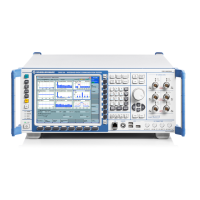Getting Started
R&S
®
CMW500
14User Manual 1173.9463.02 ─ 06
2.1.3 Starting the Instrument
Risk of instrument damage during operation
An unsuitable operating site or test setup can cause damage to the instrument and to
connected devices. Ensure the following operating conditions before you switch on the
instrument:
●
Instrument casing is closed.
●
The instrument is dry and shows no sign of condensation.
●
The instrument is positioned as described in the preceding sections.
●
The ambient temperature does not exceed the range specified in the data sheet.
●
Signal levels at the input connectors are all within the specified ranges.
●
Signal outputs are correctly connected and are not overloaded.
2.1.3.1 Powering On
The R&S CMW500 is automatically adapted to the AC supply voltage. The nominal volt-
age and frequency ranges are displayed on the rear panel and quoted in the data sheet.
The AC power connector and the main power switch are located in the upper left corner
of the rear panel.
1. Connect the instrument to the AC power supply using the AC power cable delivered
with the instrument.
2. If you have received additional cables, connect them before switching on the instru-
ment, see chapter 2.1.5, "Optional Cabling", on page 15.
3. Switch the main power switch at the rear of the instrument to position I.
The AC power switch can be permanently on. Switching off is required only if the instru-
ment must be completely removed from the AC power supply.
The R&S CMW500 is protected by two fuses located in the fuse holder to the right of the
AC power switch; see chapter 2.6.3, "Replacing Fuses", on page 49.
2.1.3.2 Starting Up and Shutting Down
The standby key is located in the bottom left corner of the front panel.
To start up the instrument
1. Make sure that the instrument is connected to the AC power supply and the power
switch on the rear panel is in position I (On).
2. If the right, amber LED is on, press the standby key on the front panel to switch the
instrument to ready state (indicated by the left, green LED).
Putting the Instrument into Operation

